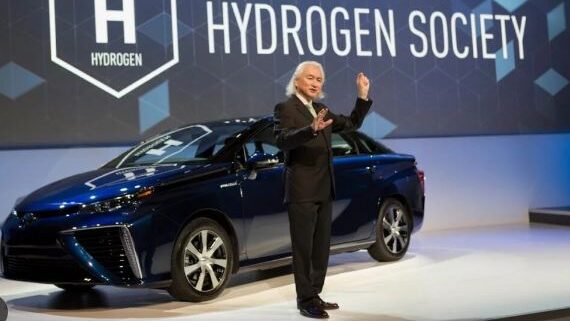Discover the positive transformation in energy sector blog- ‘Empowering Change: 6 Positive Paradigms of Future Fuels.’ Explore how innovative fuel solutions are reshaping our world, redefining the energy equation for a more sustainable 21st century. Uncover the latest breakthroughs, positive impacts, and insights into a cleaner, greener future.
1.The Evolution of Future Fuels
In the quest for sustainable energy, the evolution of future fuels signifies a transformative shift from traditional fossil fuels. These alternatives, including hydrogen, biofuels, and electricity, offer cleaner and more eco-friendly options. As the world grapples with the impact of climate change, the need for sustainable alternatives becomes increasingly urgent.
Future fuels not only reduce greenhouse gas emissions but also contribute to energy security and economic growth. The ongoing innovations, global initiatives, and collaborative efforts between governments and industries paint a promising picture of a future fueled by environmentally conscious and economically viable energy sources.

i)Understanding Future Fuels
In comprehending the landscape of future fuels, we delve into alternatives aiming to replace traditional fossil fuels. These sustainable options, such as hydrogen, biofuels, and electricity, present cleaner and eco-friendly solutions. With a rising global concern for climate change, the imperative to adopt sustainable energy becomes evident.
Future fuels not only mitigate environmental impact but also offer a pathway to energy security and economic benefits. The comprehension of these alternatives requires acknowledging their potential to reshape our energy future, fostering a cleaner and more sustainable world for generations to come.
ii)The Need for Sustainable Alternatives
As the global community confronts the pressing challenges of climate change, the imperative for sustainable alternatives to traditional fossil fuels becomes increasingly evident. The environmental impact of conventional fuels, characterized by carbon emissions and resource depletion, necessitates a shift towards cleaner energy sources.
The need for sustainable alternatives arises from the urgency to reduce our carbon footprint and mitigate the adverse effects of human activities on the planet. Embracing sustainable alternatives, such as future fuels, is pivotal for ensuring a more resilient and environmentally conscious energy ecosystem that aligns with the imperatives of a changing world.
iii)Environmental Impact of Current Fuels

The environmental impact of current fuels is a critical concern in the ongoing discourse on sustainable energy. Traditional fossil fuels, used extensively for decades, contribute significantly to environmental degradation. The extraction, processing, and consumption of these fuels lead to air and water pollution, deforestation, and the depletion of natural resources.
This detrimental cycle exacerbates climate change and poses threats to ecosystems worldwide. Recognizing the urgency of addressing these issues, there is a growing need to explore and adopt alternative energy sources. Evaluating and understanding the environmental impact of current fuels underscores the importance of transitioning towards cleaner and more sustainable energy solutions.
2.Types of Future Fuels
i)Hydrogen as a Promising Fuel
In the realm of future fuels, hydrogen stands out as a particularly promising alternative. Its potential as a clean and efficient fuel source has garnered significant attention and investment. Hydrogen, when used for energy production, produces only water vapor as a byproduct, making it a carbon-neutral option.
Governments and industries worldwide are increasingly focusing on hydrogen technologies, recognizing its role in the transition to a more sustainable energy future. From fueling vehicles to powering industrial processes, hydrogen’s versatility positions it as a key player in reducing greenhouse gas emissions and addressing the environmental challenges associated with traditional fuels.
ii)Biofuels: Harnessing Nature’s Power
In the quest for sustainable energy, biofuels emerge as a revolutionary alternative, harnessing the power of nature to meet our growing energy needs. Derived from organic materials such as plants, algae, and agricultural waste, biofuels offer a renewable and environmentally friendly solution.
The process involves converting these biological resources into fuels, reducing dependency on finite fossil fuels. Biofuels not only contribute to mitigating climate change by reducing carbon emissions but also offer a viable means of recycling organic waste. As advancements in biofuel technology continue, the potential for scalable and efficient solutions to power our future becomes increasingly promising.
iii)Electrifying the Future with Electricity
As we navigate the landscape of future fuels, electricity emerges as a transformative force, electrifying our journey towards a sustainable energy future. The rise of electric vehicles (EVs) is a testament to the increasing prominence of electricity as a fuel source.
Unlike traditional vehicles powered by internal combustion engines, EVs run on electric batteries, emitting zero tailpipe emissions. This electrification extends beyond transportation, influencing various facets of our lives, from appliances to industrial processes.
iv)The Role of Synthetic Fuels
In tandem with natural alternatives, synthetic fuels, often termed e-fuels, play a pivotal role in the transition to a cleaner energy landscape. These fuels are created through chemical processes that transform renewable resources into energy carriers. E-fuels offer the advantage of compatibility with existing infrastructure, making them a feasible option for retrofitting traditional fuel-dependent systems.The Role of Synthetic Fuels
You may also like: Top Carbon Companies (Stocks, ETFs): Navigating the Green Investment Landscape
You will also like: “Sustainable Futures: The Role of Carbon Credits in Climate Solutions”
You will also like: Carbon Credit for Farmers in India: Nurturing Sustainability and Prosperity
v) Future Fuels for Cars
“Future Fuels for Cars” herald a paradigm shift in the automotive industry, responding to the urgent need for sustainable and eco-friendly alternatives. As traditional fuels face scrutiny for environmental impact, the exploration of future fuels gains momentum. This dynamic landscape encompasses innovations like hydrogen, biofuels, and synthetic fuels, promising reduced emissions and a greener driving future. The pursuit of energy-efficient and environmentally conscious solutions defines the trajectory of “Future Fuels for Cars,” aligning with the global commitment to mitigating climate change and fostering a cleaner transportation ecosystem. As consumers increasingly embrace eco-conscious choices, the evolution of automotive fuels represents a crucial step towards a more sustainable and responsible driving experience.
vi) Sustainable Aviation Fuels 2024
“Sustainable Aviation Fuels 2024” signifies a pivotal moment in the aviation industry’s commitment to environmental responsibility. As the year unfolds, the focus on sustainable aviation fuels intensifies, driven by a collective effort to reduce carbon emissions and foster greener air travel. With advancements in technology and growing investment, 2024 is poised to witness an accelerated adoption of eco-friendly aviation fuels. These fuels, derived from renewable sources, promise to mitigate the aviation industry’s environmental impact, aligning with global sustainability goals. The exploration of “Sustainable Aviation Fuels 2024” reflects a dedication to innovation and underscores the industry’s determination to soar towards a more environmentally conscious future.
vii) Green Hydrogen Fuel
“Green Hydrogen Fuel” emerges as a beacon of hope in the quest for sustainable energy solutions. Produced through a process of electrolysis using renewable energy sources, this innovative fuel embodies environmental responsibility. Green hydrogen serves as a versatile energy carrier, with applications ranging from transportation to industrial processes. As the world increasingly pivots towards cleaner alternatives, green hydrogen fuel stands at the forefront, offering a clean and efficient option for a variety of sectors. Its potential to decarbonize industries and contribute to a carbon-neutral future makes “Green Hydrogen Fuel” a focal point of technological and environmental discussions, representing a key player in the transition to a greener and more sustainable energy landscape.
viii) Renewable Natural Gas Trends
“Renewable Natural Gas Trends” are steering the energy landscape towards eco-friendly alternatives. In an era marked by heightened environmental consciousness, the rising popularity of renewable natural gas (RNG) signifies a pivotal shift. RNG, derived from organic waste sources, is gaining prominence for its ability to reduce greenhouse gas emissions and contribute to a circular economy. As industries and consumers alike seek greener energy options, the upward trajectory of RNG aligns with global sustainability goals. The trends in RNG adoption encompass technological advancements, increased production capacities, and a growing commitment to mitigating climate change. “Renewable Natural Gas Trends” encapsulate a movement towards cleaner energy practices, signaling a future where responsible energy choices become integral to shaping a more sustainable world.
3.Advantages of Future Fuels
i)Reducing Greenhouse Gas Emissions
In the urgent pursuit of mitigating climate change, reducing greenhouse gas emissions stands as a paramount goal, and future fuels play a pivotal role in achieving this objective. Traditional fossil fuels, the primary culprits behind escalating greenhouse gas levels, contribute significantly to global warming and environmental degradation. The adoption of alternative fuels, such as hydrogen, biofuels, and electricity, offers a pathway to drastically cut down these emissions.

ii)Energy Security and Independence
Energy security and independence are critical for a nation’s stability and prosperity. Diversifying energy sources, investing in renewable technologies, and reducing dependence on foreign oil enhance resilience. A robust and sustainable energy policy ensures uninterrupted access to resources, shielding against geopolitical uncertainties.
Striving for energy self-sufficiency fosters economic strength and environmental sustainability, reinforcing a nation’s sovereignty and reducing vulnerability to external shocks. As global energy dynamics evolve, proactive measures become imperative to safeguard national interests and pave the way for a resilient and sustainable future.
iii)Economic Benefits
The adoption of future fuels holds immense potential to stimulate economic growth on multiple fronts. Embracing innovative and sustainable energy solutions not only addresses environmental concerns but also propels technological advancements, creating a fertile ground for new industries. Governments and businesses, cognizant of this potential, increasingly invest in research, development, and implementation of these technologies.
This strategic move not only boosts energy security but also generates a myriad of employment opportunities, fostering economic resilience. As the world shifts towards cleaner energy sources, the economic benefits of embracing future fuels become increasingly evident, laying the foundation for a sustainable and thriving global economy.
4.Challenges and Roadblocks
i)Technical Challenges
Despite the promise of future fuels, significant technical challenges remain. Enhancements in technology are imperative to address issues related to the efficiency, cost-effectiveness, and scalability of these alternative energy sources. Overcoming obstacles such as optimizing production processes, improving energy conversion efficiency, and developing reliable storage solutions is essential for the widespread adoption of future fuels.
Continued research and innovation are crucial to surmount these technical challenges, ensuring that these promising energy alternatives can fulfill their potential in providing sustainable and reliable solutions for the global energy landscape.
ii)Infrastructure Requirements
The shift towards future fuels necessitates substantial infrastructure development. Establishing essential components like hydrogen refueling stations and electric charging networks poses a considerable challenge, demanding significant investments and meticulous planning.
Creating a robust infrastructure backbone is vital to support the widespread adoption of alternative energy sources. Governments, businesses, and communities must collaborate to build the necessary facilities, ensuring seamless integration of future fuels into everyday transportation and energy systems. This infrastructure investment is a pivotal step in facilitating a sustainable transition, fostering the infrastructure needed to propel the adoption of cleaner and more efficient energy solutions.
iii)Public Perception and Acceptance
Public perception is pivotal for the success of future fuels. Overcoming skepticism and fostering acceptance demand effective communication, education, and awareness campaigns. Transparent communication about the benefits and safety of alternative energy sources is crucial in dispelling misconceptions. Educating the public on the positive environmental and economic impacts of future fuels helps build support for their widespread adoption.
Awareness campaigns should highlight the role of these fuels in mitigating climate change and enhancing energy security. By addressing concerns and promoting understanding, a positive public perception can be cultivated, laying the foundation for the successful integration of future fuels into the mainstream energy landscape.
5.Innovations & Breakthroughs
i)Cutting-Edge Technologies
Cutting-edge technologies propel the future fuels sector, shaping a sustainable energy landscape. Breakthroughs in hydrogen production and advancements in biofuel processing are at the forefront of innovation. Continuous research and development drive these transformative changes, enhancing the efficiency and viability of alternative energy sources.
As technology evolves, so does the potential for cleaner and more sustainable fuel solutions. This ongoing commitment to innovation not only addresses current challenges but also opens new possibilities, demonstrating the dynamic nature of the future fuels sector as it strives to meet the world’s growing energy needs in an environmentally conscious manner.
ii)Research and Development Initiatives
Research and Development (R&D) initiatives are instrumental in shaping the future of energy. Investments in R&D drive innovation, fostering advancements across diverse energy sectors. From renewable technologies to energy storage solutions, ongoing research initiatives aim to enhance efficiency, reduce costs, and promote sustainability.
Governments, private enterprises, and academic institutions collaborate to fund and conduct R&D projects, exploring novel concepts and pushing the boundaries of energy science. These initiatives not only drive economic growth but also play a crucial role in addressing global challenges such as climate change. The continuous pursuit of knowledge through R&D remains a cornerstone in building a more sustainable and resilient energy future.
6.Future Fuel Adoption Around the World
i)Global Initiatives
Countries worldwide are increasingly acknowledging the significance of future fuels in attaining sustainability objectives. Global initiatives and collaborations are actively in progress, facilitating the exchange of knowledge, resources, and technologies to accelerate the adoption of clean energy sources. Recognizing the interdependence of environmental challenges, nations are pooling efforts to address common concerns and promote the transition to sustainable energy.
These collaborative endeavors signify a collective commitment to mitigating climate change and fostering a shared vision of a cleaner, more resilient future. The international cooperation in advancing future fuels underscores the global community’s commitment to sustainable and environmentally conscious energy practices.
ii)Success Stories
Numerous nations have seamlessly integrated future fuels into their diverse energy portfolios. Case studies and success stories offer valuable insights into overcoming challenges and realizing the substantial benefits of adopting sustainable fuels. These examples showcase the practical application of innovative technologies, demonstrating how countries can achieve energy security and environmental sustainability simultaneously.
By examining these success stories, other nations can draw inspiration and develop strategies for effective implementation. Sharing such experiences fosters a collaborative global effort towards a cleaner energy future, emphasizing the practical feasibility and advantages of incorporating future fuels into comprehensive energy strategies.
iii)Challenges in Different Regions
The pursuit of a cleaner and sustainable future is a shared objective, yet distinct regions encounter unique challenges in embracing future fuels. Economic conditions, existing infrastructure, and cultural attitudes exert considerable influence on the pace of transition. Economic disparities can impact investment capacity, while varying infrastructure levels present hurdles in adopting advanced fuel technologies.
Additionally, cultural attitudes towards energy sources shape public acceptance. Acknowledging these diverse challenges is crucial for tailoring effective strategies, ensuring that the transition to future fuels is not only environmentally beneficial but also socially and economically feasible in different global contexts.
7.The Role of Governments and Industries
i)Policy Frameworks
Governments play a pivotal role in shaping the future fuel landscape through strategic policy frameworks. Incentives, regulations, and subsidies form crucial components that can motivate industries and consumers to embrace cleaner energy solutions. By providing financial incentives and regulatory support, governments stimulate investment in research, development, and adoption of sustainable technologies.
Well-crafted policies create a conducive environment, fostering innovation and market competitiveness in the future fuel sector. As key drivers of change, governments can effectively steer the transition towards cleaner energy, aligning national interests with global sustainability goals and encouraging the widespread adoption of environmentally friendly fuel alternatives.
ii)Investments and Collaborations
Collaboration between governments and industries is essential for driving innovation and scaling up future fuel technologies. Financial investments, research partnerships, and collaborative projects create a conducive environment for sustainable energy development. Governments, with their regulatory frameworks and funding support, can incentivize industries to invest in research and development of future fuels.
Industry collaboration ensures that innovative technologies are not only developed but also brought to market efficiently. This synergistic approach between public and private sectors establishes a robust foundation for advancing sustainable energy solutions, fostering a collective effort towards a cleaner and more resilient energy future.
8.Future Fuels in Transportation
i)Electric Vehicles Revolution
The “Electric Vehicles (EV) Revolution” marks a transformative shift in the automotive landscape. As concerns about climate change and air quality intensify, governments, industries, and consumers globally are embracing electric mobility. The rise of EVs is driven by technological advancements in battery technology, making electric cars more affordable and accessible.
Governments play a crucial role by offering incentives, subsidies, and infrastructure development, creating an environment conducive to EV adoption. Industries are investing heavily in research and development, driving innovation in EV design and performance. This revolution not only reduces carbon emissions but also signifies a pivotal step towards sustainable and eco-friendly transportation.
ii)Aviation and Maritime Solutions
The pursuit of sustainable transportation extends to aviation and maritime sectors, driving innovations for “Aviation and Maritime Solutions.” As environmental concerns intensify, these industries are exploring cleaner technologies and alternative fuels to reduce their carbon footprint. Biofuels, electric propulsion, and hydrogen-based technologies are emerging as viable alternatives. Governments, recognizing the need for eco-friendly practices, are incentivizing research and development in these sectors.
Collaborations between industry stakeholders and environmental organizations are fostering advancements in fuel efficiency and emissions reduction. The ongoing efforts in aviation and maritime solutions underscore a commitment to environmentally responsible practices, aiming for a more sustainable and greener future in transportation.
9.The Impact on Everyday Life
i)Consumer Choices and Impact
As future fuels become more accessible, consumers gain the power to make sustainable choices. Whether opting for electric cars or biofuel-powered appliances, the impact on everyday life extends beyond energy sources, influencing various aspects of consumption. This shift empowers individuals to contribute to environmental sustainability through their purchasing decisions.
As consumer demand for eco-friendly options rises, industries are incentivized to further develop and adopt future fuels. This collective effort not only transforms personal lifestyles but also plays a significant role in shaping a more sustainable and environmentally conscious future.
ii)Transitioning Industries
Industries reliant on traditional fuels are undergoing a transformative phase. The shift towards future fuels is reshaping processes, supply chains, and business models, impacting sectors from manufacturing to agriculture. This transition reflects a broader commitment to sustainability, influencing how industries operate and adapt to cleaner energy sources.
As businesses increasingly integrate future fuels into their operations, the ripple effects are seen in improved environmental practices, energy efficiency, and a fundamental change in how products are produced and delivered across diverse sectors.
10.Future Fuel and Sustainable Development Goals
i)Aligning with Environmental Targets
“Aligning with Environmental Targets” is a strategic imperative that emphasizes the commitment of individuals, businesses, and governments to embrace sustainable practices. Meeting environmental targets involves adopting eco-friendly technologies, reducing carbon footprints, and promoting conservation efforts. This alignment requires a holistic approach, integrating renewable energy sources, implementing efficient waste management, and prioritizing biodiversity conservation.
By adhering to established environmental targets, stakeholders contribute to mitigating climate change, preserving ecosystems, and building a more sustainable and resilient future for the planet. The collective commitment to these targets ensures a harmonious coexistence between human activities and the environment.
ii)Contribution to a Greener Planet
“Contribution to a Greener Planet” underscores the collective efforts aimed at fostering environmental sustainability. Individuals, businesses, and governments play pivotal roles in this global initiative. By embracing eco-friendly practices, such as reducing carbon emissions, conserving resources, and supporting renewable energy, a positive impact on the environment is achieved.
Sustainable choices in daily life, green technologies in industries, and policies prioritizing environmental conservation all contribute to building a greener planet. This shared commitment not only addresses current environmental challenges but also lays the groundwork for a more resilient and harmonious coexistence between humanity and the Earth.
11.Conclusion
In conclusion, the journey towards future fuels represents a significant paradigm shift in our energy landscape. The ongoing innovations, international collaborations, and the shared commitment to sustainability are steering us towards a promising path. Future fuels, encompassing diverse technologies and cleaner energy sources, hold the potential to create a cleaner, more resilient world.
As we continue to advance, it is imperative to nurture these developments through continued research, supportive policies, and widespread adoption. This transformative journey reflects not just a change in energy sources but a collective effort to build a more sustainable and environmentally responsible future for our planet.
12. FAQs (Frequently Asked Questions):
Q1: How do future fuels differ from traditional fossil fuels?
Q2: What role do governments play in promoting future fuels?
Q3: Are there any success stories of countries embracing future fuels?
Q4: What challenges do future fuels face in terms of public acceptance?
Q5: How can individuals contribute to the future fuel transition in their daily lives?
Q6.What are some examples of future fuels?
Q7. What role does hydrogen play in the future of fuel technology?
Q8. How are synthetic fuels created, and what advantages do they offer?
Q9. What challenges do we face in the widespread adoption of future fuels?
Q10. How can future fuels contribute to global efforts to combat climate change?
Q11. What initiatives and policies are in place to promote the development and adoption of future fuels?
Q12. How can consumers actively participate in the transition to future fuels?


Pingback: Dual Engine Cars Revolutionize Your Drive: 5 Powerful Reason
Pingback: Hydrogen Cars The Power of Green: Bright Tomorrow Revolution
Pingback: SkymoviesHD Revolutionize Your Streaming Experience: The 3 Explosive Features on That Will Blow Your Mind - NextGenrationTech.coM